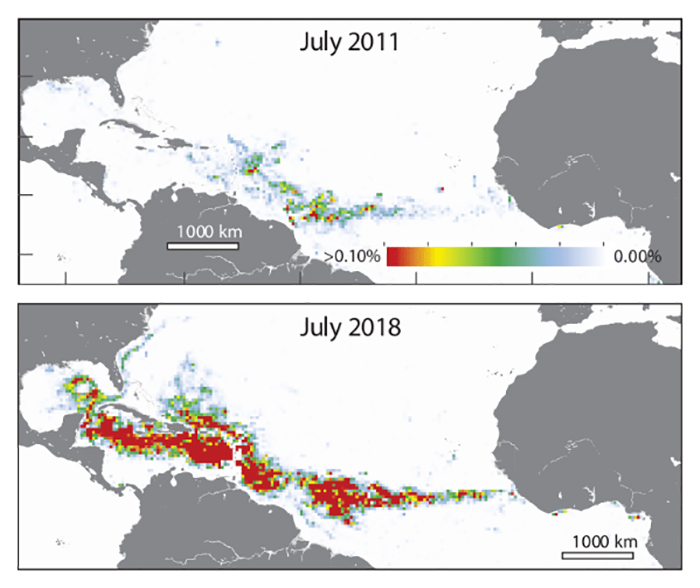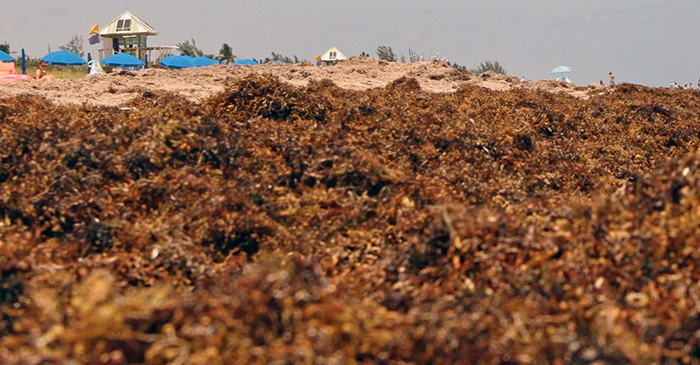Scientists have measured what they say is the largest seaweed bloom on record, stretching 8,850 kilometres (nearly 5,500 miles) across the Atlantic Ocean and made up of some 20 million metric tons of Sargassum algae – more than the weight of 200 fully loaded aircraft carriers.
The Great Atlantic Sargassum Belt, as it's being called, is expanding due to nutrients washed out from the Amazon river on one side and the West African coast on the other, some of which may be due to increased deforestation and fertiliser use.
Using satellite data from NASA as well as samples collected in the field, the researchers have identified a tipping point that happened back in 2011. Since then, there have been major blooms almost every year, and there's no sign of that trend changing – the latest spread stretched all the way from West Africa to the Gulf of Mexico.
 Spreading sargassum. (Wang et al., Science., 2019)
Spreading sargassum. (Wang et al., Science., 2019)
The scientists have linked that change to an increase in deforestation and fertiliser use in Brazil and across the Amazon, beginning at the start of the decade, though the association isn't yet clear-cut.
While the researchers aren't ready to say exactly what's causing the bloom, they feel confident it's not going away any time soon.
"The evidence for nutrient enrichment is preliminary and based on limited field data and other environmental data, and we need more research to confirm this hypothesis," says study leader and oceanographer Chuanmin Hu, from the University of South Florida.
"On the other hand, based on the last 20 years of data, I can say that the belt is very likely to be a new normal."
So what does this mammoth bloom mean for our oceans? Unfortunately we don't know enough to say just yet.
Seaweed blooms like this aren't necessarily bad for the ocean: sargassum provides habitats for turtles, crabs, fish and birds, while also producing oxygen for marine life to live off through the process of photosynthesis.
But too much of the algae can cause problems, in terms of restricting the movement and breathing of certain marine species, especially around coastal regions. After it dies, the sargassum can choke corals and seagrass if there's too much of it in the water.
Rotting sargassum on the beach also gives off a rotten egg smell thanks to the hydrogen sulphide it releases, and that means an unpleasant experience for locals and tourists, as well as potential impacts on health (for those with asthma, for example).
 (Brian Cousin/Florida Atlantic University's Harbor Branch Oceanographic Institute)
(Brian Cousin/Florida Atlantic University's Harbor Branch Oceanographic Institute)
The size of the blooms now peak between April and July before slowly dissipating, but some seeds that get left over in the winter then go on to contribute to larger swathes of sargassum the next summer.
"The ocean's chemistry must have changed in order for the blooms to get so out of hand," says Hu. "They are probably here to stay."
Many factors play into sargassum growth, including the salinity and temperature of the water, and as yet the scientists don't have direct readings for nutrient levels for all the years covered by the study – in some cases it's been estimated based on other signals.
In 2011 the bloom was particularly widespread, and we're still seeing the momentum for that now. As well as more nutrients being discharged from the Amazon river, the researchers say, an upwelling or rising in the sea level off West Africa also contributed more nutrients (lifted up from deeper water to the surface).
Ultimately that led to the enormous bloom that was recorded last summer and detailed in this new study. Now they know the extent of it, the researchers want to further investigate its causes and possible consequences – on precipitation, ocean currents, human activity and more.
"We hope this provides a framework for improved understanding and response to this emerging phenomenon," says Hu. "We need a lot more follow-on work."
The research has been published in Science.
#Environment | https://sciencespies.com/environment/scientists-discover-the-largest-seaweed-bloom-ever-found-and-its-still-growing/
No comments:
Post a Comment